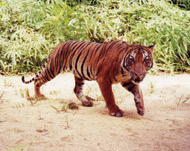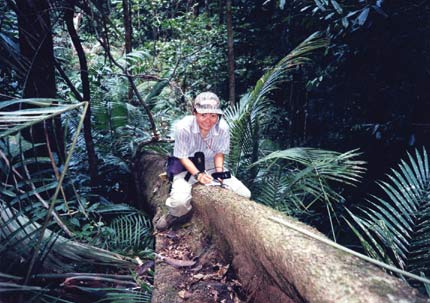downloadable
.pdf
 Researcher
Dodges Elephants, Mudslides to Track Tigers Researcher
Dodges Elephants, Mudslides to Track Tigers
Of
the estimated 7,000 tigers left in the world, scientists know
the least about the roughly 2,000 thought to remain in Southeast
Asia.
Unstable
or repressive political conditions have long impeded Western
biologists trying to study tigers there. Much of the big cats’
habitat, meanwhile, consists of remote, extremely wild rain
forest that offers near-perfect cover to the shy and elusive
predators.
So
tiger experts are hailing a new study of the tiger population
in Malaysia as something of a landmark in research and conservation
of the animals. The study, by recent University of Florida
graduate Kae Kawanishi, provides the first scientifically
rigorous estimate of a tiger population in Malaysia and one
of the first such studies in the entire region. These studies
are important because they will aid conservation efforts in
an area facing huge population and development pressures,
experts say.
The
research “has greatly advanced our understanding of
the dynamics of tigers and their prey and, for the first time,
given us a holistic picture of tigers living in the rain forest,”
said John Seidensticker, a research scientist at the Smithsonian’s
National Zoological Park in Washington, D.C., and chairman
of ExxonMobil’s Save The Tiger Fund Council. “This
is essential to securing the tiger’s future through
much of the rain forest remaining in Southeast Asia.”
 |
| Researchers
had to watch out for elephants and poisonous snakes, while
the rain forest's mammoth trees stand on thin, eroding
soil and frequently fall over. Here Florida graduate student
Kae Kawanishi climbs along a fallen tree trunk. |
Based
on 61 photos of tigers taken by self-activating cameras in
Taman Negara National Park, a 1,677-square-mile protected
area that is one of the largest parks in Southeast Asia, Kawanishi
used population models to estimate that the park supported
a population of between 52 and 84 adult tigers. Equally significant,
she found no evidence of illegal hunting or other human-induced
threats to the tigers.
“When
you compare that result with the threat to tiger populations
in similar-sized parks in other tiger ranges, Taman Negara
is unique and superb,” said Kawanishi, now a technical
adviser for research and conservation for the Malaysian national
park system.
But
while her results are important, the grueling, nearly three
years that Kawanashi endured in the rain forest also highlight
the huge challenges
and sacrifices faced by many wildlife biologists.
Kawanishi,
35, who graduated in December with her doctorate in wildlife
ecology and conservation, began her field work in 1998 at
Taman Negara. With only one eight-mile road and few trails,
the park is among the world’s wildest regions.
Wildlife
biologists trying to estimate tiger populations and gauge
their ranges have long relied on their tracks or on capturing
the tigers and fitting them with radio collars. However, neither
method works in the rain forest, where tracks are hard to
find, or lose definition, and vegetation blunts radio signals.
As
a result, Kawanishi used “camera traps” consisting
of self-activating cameras set up along game trails or other
spots where tigers were likely to visit. Dominated by huge,
ancient trees with rivers and streams cutting through valleys,
Taman Negara’s terrain made setting up and monitoring
the cameras a mammoth, risky project.
Kawanishi
and a support team of several Malaysian assistants and rangers
set up some 150 camera traps on three 75-square-mile study
sites. At two of the sites, the team spent at least two days
on a boat just to reach base camp — trips that often
included portaging over shallow areas. The team then had to
hike several hours to reach each camera.
Hazards
were numerous. For one thing, the rain forest’s mammoth
trees stand on thin, eroding soil and frequently fall over,
bringing down many smaller trees and vegetation with them.
Researchers
also had to watch out for elephants and poisonous snakes,
while insects, leeches and other pests were a constant annoyance.
The
researchers sampled each of the three sites for 11 months.
But their perseverance paid off. The team wound up with thousands
of photos of reptiles, numerous birds and mammals, including
porcupines, wild dogs, sun bears, elephants and mouse deer.
Among other potentially important findings, Kawanishi said
the team also captured the first evidence of the rare Storm’s
stork in the park and found that all leopards (about 150 were
photographed) are melanistic, or largely black, because of
a recessive gene. During her time in the rain forest, Kawanishi
never saw a tiger — but her 61 photos of the animals
were adequate for the study to succeed.
by
Aaron Hoover
|

